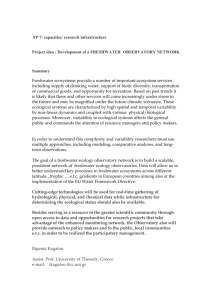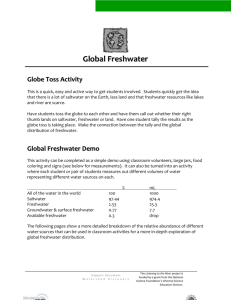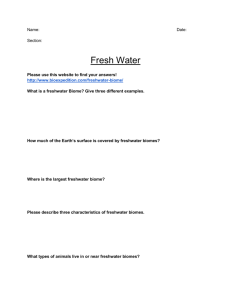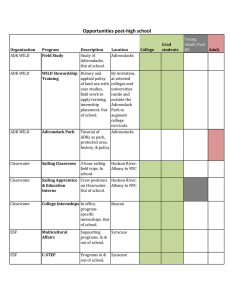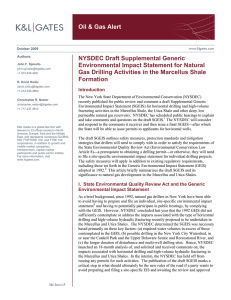NYS Large Volume Wat..
advertisement
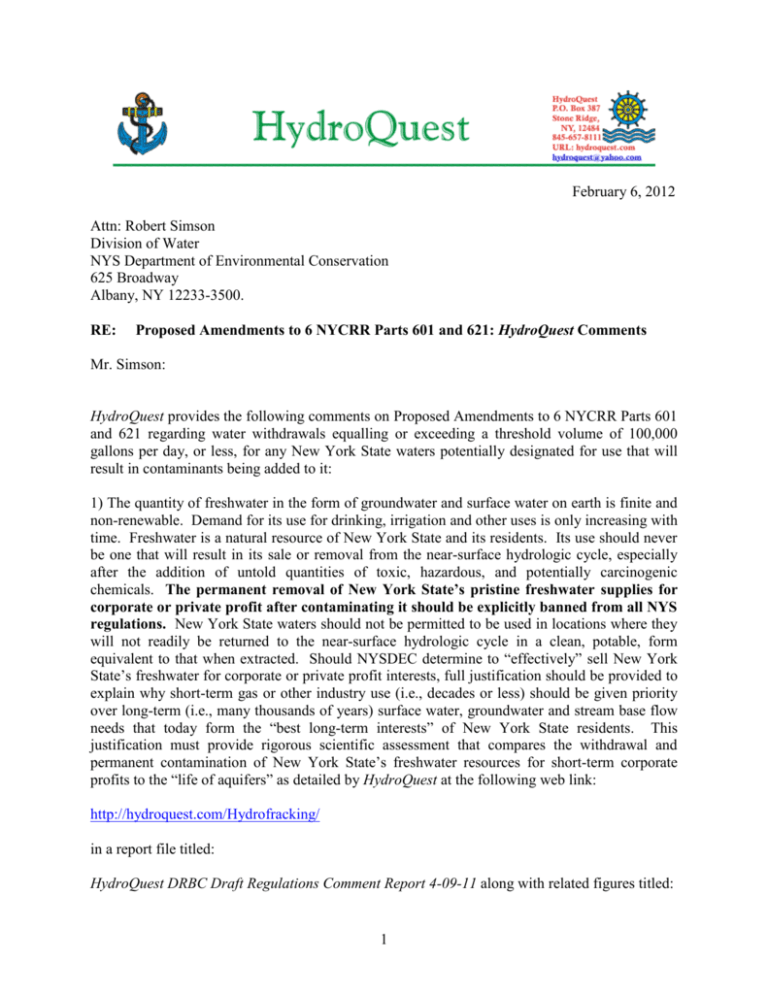
February 6, 2012 Attn: Robert Simson Division of Water NYS Department of Environmental Conservation 625 Broadway Albany, NY 12233-3500. RE: Proposed Amendments to 6 NYCRR Parts 601 and 621: HydroQuest Comments Mr. Simson: HydroQuest provides the following comments on Proposed Amendments to 6 NYCRR Parts 601 and 621 regarding water withdrawals equalling or exceeding a threshold volume of 100,000 gallons per day, or less, for any New York State waters potentially designated for use that will result in contaminants being added to it: 1) The quantity of freshwater in the form of groundwater and surface water on earth is finite and non-renewable. Demand for its use for drinking, irrigation and other uses is only increasing with time. Freshwater is a natural resource of New York State and its residents. Its use should never be one that will result in its sale or removal from the near-surface hydrologic cycle, especially after the addition of untold quantities of toxic, hazardous, and potentially carcinogenic chemicals. The permanent removal of New York State’s pristine freshwater supplies for corporate or private profit after contaminating it should be explicitly banned from all NYS regulations. New York State waters should not be permitted to be used in locations where they will not readily be returned to the near-surface hydrologic cycle in a clean, potable, form equivalent to that when extracted. Should NYSDEC determine to “effectively” sell New York State’s freshwater for corporate or private profit interests, full justification should be provided to explain why short-term gas or other industry use (i.e., decades or less) should be given priority over long-term (i.e., many thousands of years) surface water, groundwater and stream base flow needs that today form the “best long-term interests” of New York State residents. This justification must provide rigorous scientific assessment that compares the withdrawal and permanent contamination of New York State’s freshwater resources for short-term corporate profits to the “life of aquifers” as detailed by HydroQuest at the following web link: http://hydroquest.com/Hydrofracking/ in a report file titled: HydroQuest DRBC Draft Regulations Comment Report 4-09-11 along with related figures titled: 1 April 9, 2011 DRBC Comment Report Figures AND on a Fact Sheet also available at the same web link. The two files of the Fact Sheet are: Aquifer Protection Expert Fact Sheet Front 9-2-11 and Aquifer Protection Expert Fact Sheet Back 9-2-11. These documents are hereby incorporated by reference into these HydroQuest comments. As such, no further regulatory actions should be considered until after such time as full justification has been provided for full public review and comment; 2) Should sufficient rationale survive public scrutiny, as determined via the method described in 1) above, to permanently remove and degrade New York State’s freshwater resources, absolutely no water should be permitted to be injected underground until the NYSDEC well plugging and abandonment program has advanced to a point where NYSDEC is in full, demonstrated, compliance with their own regulations and all unaccounted for, unplugged, and poorly plugged gas and oil wells have been fully plugged and abandoned (i.e., 100 percent). To do otherwise would jeopardize the quality of existing freshwater aquifers as contaminants would rise upward along unplugged borehole conduit pathways into overlying, unprotected, aquifers. Dr. Ron Bishop has used NYSDEC records to show that NYSDEC cannot and has not adequately met their own regulatory statutes regarding plugging and abandonment of oil and gas wells. His report on this ongoing failure is hereby incorporated by reference here. It may be viewed and downloaded from: http://hydroquest.com/Hydrofracking/ at a file titled: Bishop – NYS Regulatory Well Plugging Failure. For the web site only and ease of reference, I retitled Dr. Bishop’s paper that is actually titled: History of Oil and Gas Well Abandonment in New York. Dr. Bishop makes the solid case using NYSDEC data that we have no business proceeding with new wells or regulations without first finding and properly plugging all existing abandoned wells. NYS is miserably failing to deal with existing well problems in their current regulatory program. On page 10 of his report, Dr. Bishop concludes: “Under current regulatory conditions, the advent of high-volume, hydraulically-fractured (HVHF) shale gas development to New York can reasonably be expected to result in an escalation of environmental and public health impacts, due to the increased scale of shale gas projects and compressed time frames for project development and decline. Therefore, this author’s first recommendation is to prohibit all HVHF projects until: (a) All oil and gas wells in New York State which are known or suspected to require plugging have been added to the priority plugging list, and (b) Every well on that list has been plugged and the area reclaimed. 2 The objective would be to demonstrate oil and gas industry compliance with existing laws before approving any more intensive industry operations in the state.” Because much of the high volume water extraction contemplated under these regulations is for purposes of advancing gas drilling efforts, a moratorium should be placed on any advancement of the proposed amendments to 6 NYCRR Parts 601 and 621 until all the recommendations made by Dr. Bishop have been met. Anything less would not be prudent and could not possibly merit defensible regulatory advancement; and 3) At such point in time that the conditions of 1) and 2) above have been met and NYSDEC is then in a position to advance the contemplated regulations, an important additional factor should be added to regulatory requirements – all freshwaters removed from New York State natural resources and intentionally contaminated for gas industry or other use must be tagged with nonnaturally occurring tracers so that full cradle-to-grave accountability of these waters is possible. Tracers must be required because it is certain that once clean freshwater will ultimately contaminate New York State homeowner wells, aquifers, and surface water resources. Again, because much of the large volume water extractions as contemplated in these amendments are explicitly for the gas industry, the related contaminant risks must be fully addressed. The costly burden of legal, chemical, and hydrogeologic proof incumbent upon adversely impacted homeowners is onerous and overwhelming. This situation must be remedied BEFORE any additional gas drilling is permitted in NYS, especially with New York State’s pristine and finite freshwater resources. This can easily be done by simply requiring the addition of gas or other company/industry tracers in all fluids injected underground – inclusive of all freshwaters extracted from New York State resources as proposed in amendments to 6 NYCRR Parts 601 and 621; Non-naturally occurring tracers must be added to all freshwaters extracted from New York State resources that will intentionally be contaminated, regardless of the volume extracted. This includes all water withdrawn for the purpose of addition to gas field drilling and hydraulic fracturing fluids. By tagging ALL freshwaters withdrawn for uses with planned contaminant additions and underground injection with tracers, contaminant excursions can reliably and immediately be assigned to gas companies or other industries, or not, without expensive cost and litigation to homeowners. This measure will afford homeowners the environmental protection the NYSDEC is charged with providing and will provide assurance of rapid connection to alternate water supplies by gas companies or other industries should their actions result in groundwater or surface water contamination. There is absolutely no reason to not require tracer additions to New York State waters withdrawn with the intent of permanently removing them from our finite water supply. Tracer selection, concentrations and required detection limits should be determined by an independent panel of tracer experts. Failure to adopt this recommended regulatory amendment would essentially leave adversely impacted homeowners with no financially viable and time-effective recourse and, thus, should provide scientific and legal cause to discard any of the proposed amendments to 6 NYCRR Parts 601 and 621; and 3 4) Finally, and very importantly, the comments made herein relative to high-volume water withdrawals should NOT be limited to withdrawals in excess of 100,000 gallons per day. Instead, they should apply to ALL planned New York State water withdrawals contemplated with the explicit intent of contaminating them such that they will permanently be removed from the shallow near-surface hydrologic cycle. To exempt such water withdrawals of less than 100,000 gallons per day from full regulatory accountability as proposed in the proposed amendments would be irresponsible, not in the best interests of New York State residents, and should be construed as grounds for legal recourse. Thank you for your full consideration of the recommendations made here. Sincerely, Paul A. Rubin Hydrogeologist HydroQuest 4


